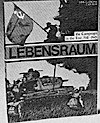
Designed by Stephen Newberg
Simulations Canada
P.O. Box 452, Bridgewater,
Nova Scotia, Canada B4V 2X6
Released: 1984
Price: $15 ziplock, $20 boxed
Complexity: Intermediate
Solitaire Suitability: Low
**
Lebensraum is a grand strategic game of the Eastern Front of World War II. As the latest attempt to recreate this theater, it is not innovative enough to warrant the hefty price tag.
The game comes with 400 well-done die cut counters, a colorful 22 X 28 inch map covering the operations area, and a rule book whose cover doubles for the artwork for the box (or bag) cover. For the money, I would have expected something a little more classy.
Lebensraum attempts to place the players in the shoes of Hitler and Stalin, making all the military and economic decisions of their respective countries. Each turn represents three months of actual time, each hex is over 2,000 square miles, and each counter represents an army or army group. All facets of strategic warfare such as leadership, airpower, naval support operations, partisans, industrial production, and transportation networks are included in the game.
The rule book takes a bit of wading through. Written in large double columns and with no illustrations to break up the text, plowing through its pages takes some stamina. The rules do seem quite complete, however.
As a game, Lebensraum fails to offer anything new in the realm of strategic simulations. SPI's old Battle for Germany game covered much of the same ground, and was a lot more fun to play, mostly because it chose to ignore such tedious aspects as industrial production, supply, or economic transport. Unfortunately, these are the sort of things that the designer of Lebensraum has accentuated, making the game more of a war of national economies than of armies. This attitude is reflected in the facings of the counters in the game. None of the symbols that are considered standard in the gaming industry for military units (the NATO symbols) are used here. Instead each counter has a strength number, a quality letter, and the abbreviation of that army's designation (such as IPZ or 641NF). You cannot easily identify units at a glance, mainly because it really doesn't matter. At this scale the only difference between armor and infantry is that the counters are shaded a bit differently.
Perhaps this is what the designer intended: a game with the players handling all the decisions that face a national leader, including the boring ones. For those of you whose favorite game setting is the Eastern front of World War II, perhaps Lebensraum is for you. And for those who enjoy game systems with an emphasis on economic factors, there is talk of a Lebensraum companion game to recreate the Western Front of World War II, entitled, originally enough, West Front.
Lebensraum leaves much to be desired; they don't even include a die. if I were you, I'd save my $20.00 for the next World War II Eastern Front game.
More War Game Reviews
-
Game Review: Napoleon's Last Battles: Quadrigame of the Waterloo Campaign
Game Review: Rome and the Barbarians
Game Review: Warhammer: Fantasy Battle Rules, Second Edition
Game Review: Lebensraum: The Campaign in the East, 1941-1945
Game Review: Pax Brittanica: The Colonial Era from 1880 to The Great War
Back to Table of Contents -- Game News #7
To Game News List of Issues
To MagWeb Master Magazine List
© Copyright 1985 by Dana Lombardy.
This article appears in MagWeb (Magazine Web) on the Internet World Wide Web.
Other military history articles and gaming articles are available at http://www.magweb.com